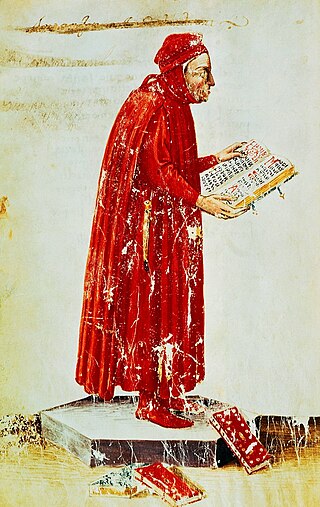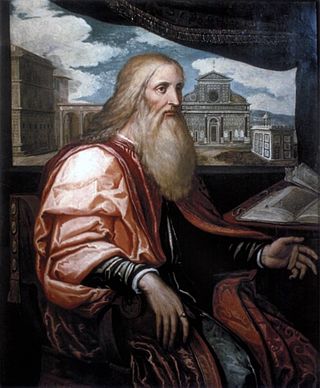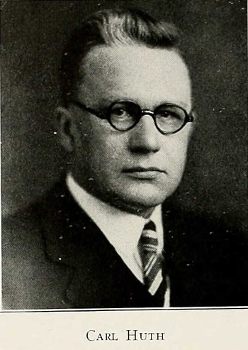
The Aldine Press was the printing office started by Aldus Manutius in 1494 in Venice, from which were issued the celebrated Aldine editions of the classics. The first book that was dated and printed under his name appeared in 1495.

Coluccio Salutati was an Italian Renaissance humanist and notary, and one of the most important political and cultural leaders of Renaissance Florence; as chancellor of the Florentine Republic and its most prominent voice, he was effectively the permanent secretary of state in the generation before the rise of the powerful Medici family.

Teachers College, Columbia University (TC) is the graduate school of education, health, and psychology of Columbia University, a private research university in New York City. Founded in 1887, Teachers College has served as one of the official Faculties and the Department of Education of Columbia University since 1898. It is the oldest and largest graduate school of education in the United States.

Graduate School of Architecture, Planning and Preservation (GSAPP) is the architecture school of Columbia University, a private research university in New York City. It is also home to the Masters of Science program in Advanced Architectural Design, Historic Preservation, Real Estate Development, Urban Design, and Urban Planning.

Stephen Guild Kurtz was an American academic and educator, who served as the eleventh principal of Phillips Exeter Academy.
Giovanni Antonio Campani called Campanus, a protégé of Cardinal Bessarion, was a Neapolitan-born humanist at the court of Pope Pius II, whose funeral oration he wrote, followed by a biography, flattering but filled with personal reminiscence, written ca 1470-77. Campanus was famous for his Latin orations, poems and letters. In addition to Bessarion's Academy, Campanus was a member of the Roman circle of Pomponius Leto. After the death of the Pope in 1464, Campani taught at the Florentine Academy.
Giacomo Mazzocchi, in Latin on his titlepages Jacobus Mazochius, was a learned bookseller, printer, and noted antiquarian in papal Rome during the High Renaissance. A native of Bergamo, Mazzocchi is first heard of in 1505 as provider of finance for an edition of Vibius Sequester De fluminibus printed by J. Besicken of Rome. By 1509 Mazzocchi was himself in business as a printer. For humanists he might publish such scholarly works as the first printed repertory of Roman inscriptions, Epigrammata Antiquae Urbis, a folio of some 3,000 inscriptions, mostly of epitaphs, in which his collaborator was the Florentine priest Francesco Albertini This work includes inscriptions ranging from Roman Republican times to the age of Justinian I and is illustrated with somewhat stylised woodcuts showing some of the buildings and monuments of Rome, such as the Pantheon, the Arch of Constantine and the Pyramid of Cestius.

Wilfred Conwell Bain was an American music educator, a university level music school administrator, and an opera theater director at the collegiate level. Bain is widely credited for rapidly transforming to national prominence both the University of North Texas College of Music as dean from 1938 to 1947, and later, Indiana University School of Music as dean from 1947 to 1973. Both institutions are major comprehensive music schools with the largest and second largest enrollments, respectively, of all music schools accredited by the National Association of Schools of Music. He was born in Shawville, Quebec, and died in Bloomington, Indiana.

Antonio Mancinelli was a humanist pedagogue, grammarian, and rhetorician from Velletri who taught in Venice, Rome, and Orvieto. He produced editions of Cicero, Herodotus, Horace, Juvenal, Suetonius, Virgil, and many other authors. His Carmen de Figuris rendered parts of Quintilian's rhetoric in hexameter.

Ars Historica was a genre of humanist historiography in the later Renaissance. It produced a small library of treatises underscoring the stylistic aspects of writing history as a work of art, but also introducing the contributions of philology and textual criticism in its precepts and evaluations.

Bernardo Rucellai, also known as Bernardo di Giovanni Rucellai or Latinised as Bernardus Oricellarius, was a member of the Florentine political and social elite. He was the son of Giovanni di Paolo Rucellai (1403–1481) and father of Giovanni di Bernardo Rucellai (1475–1525). He was married to Nannina de' Medici, the elder sister of Lorenzo de' Medici, and was thus uncle to Popes Leo X and Clement VII, who were cousins. Oligarch, banker, ambassador and man of letters, he is today remembered principally for the meetings of the members of the Accademia Platonica in the Orti Oricellari, the gardens of his house in Florence, the Palazzo Rucellai, where Niccolò Machiavelli gave readings of his Discorsi.

Margarete Bieber was a Jewish German-American art historian, classical archaeologist and professor. She became the second woman university professor in Germany in 1919 when she took a position at the University of Giessen. She studied the theatre of ancient Greece and Rome as well as the sculpture and clothing in ancient Rome and Greece.
Clyde Pharr was an American classics professor at Ohio Wesleyan University, Southwestern Presbyterian University, Vanderbilt University, and, finally, at the University of Texas at Austin.

Giovanni Rucellai, known by his name with the patronymic Giovanni di Paolo Rucellai, was a member of a wealthy family of wool merchants in Renaissance Florence, in Tuscany, Italy. He held political posts under Cosimo and Lorenzo de' Medici, but is principally remembered for building Palazzo Rucellai and the Rucellai Sepulchre, for his patronage of the marble façade of the church of Santa Maria Novella, and as author of an important Zibaldone. He was the father of Bernardo Rucellai (1448–1514) and grandfather of Giovanni di Bernardo Rucellai (1475–1525).

Frank John Coppa was an American historian, author, and educator who wrote widely on the Papacy in history as well as on Italian historical topics.
Robert Lee Hess was an American scholar of African history, and the sixth President of Brooklyn College.
Sarah B. Pomeroy is an American Professor of Classics.

Carl Louis Frederick Huth was an American historian, geographer, editor, translator, educator, and administrator at the University of Chicago.

Robert Herndon Fife Jr. was an American academic who specialized in German studies and served as Gebhard Professor of German and Chair of the German Department at Columbia University. He was the founder of The Germanic Review, former President of the AATG and President of the MLA. Fife wrote on German history, German language and literature, Martin Luther, and German romanticism and edited works by Heinrich Heine, E. T. A. Hoffmann and Ludwig Tieck.
Italians in North America before 1880 included a number of explorers, starting with Christopher Columbus, and a few small settlements.














